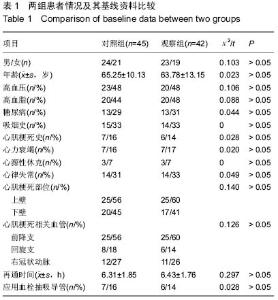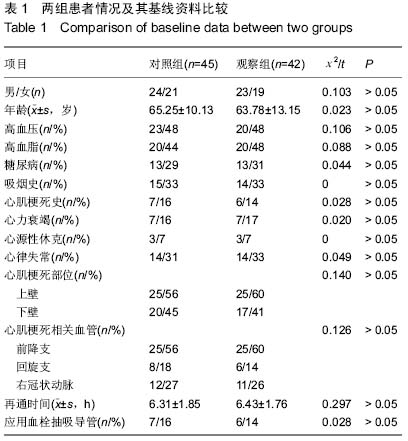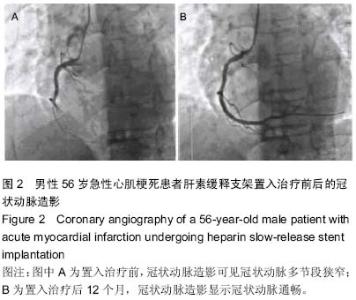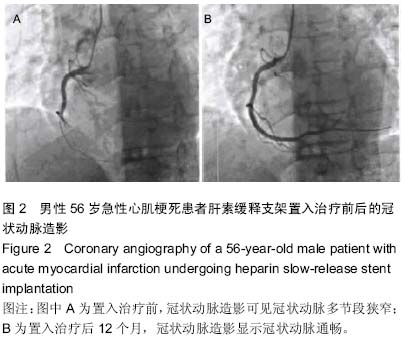| [1] 李江,朱佳佳,康铁朵,等.依诺肝素联合替罗非班治疗急性心肌梗死的有效性与安全性分析[J].心肺血管病杂志,2013,32(2): 152-154.
[2] 刘月驹,张光伟,刘晓程,等.肝素缓释可降解支架在心肌血运重建中的应用研究[J].天津医药,2010,38(8):693-695,后插2.
[3] 沈雳,吴轶喆,张峰,等.血管内超声评价壳聚糖/肝素层层自组装涂层支架贴壁情况及对猪冠状动脉重构的影响[J].中华心血管病杂志,2012,40(7):569-574.
[4] 丁付燕,吕志前,王瑾晔,等.新型地塞米松-肝素双涂层支架在小型猪动脉损伤模型中预防支架内再狭窄的实验研究[J].国际心血管病杂志,2011,38(1):52-55.
[5] 王颖.骨髓间充质干细胞移植结合碱性成纤维细胞生长因子/肝素缓释支架在猪心肌血运重建中的实验研究[D].北京协和医学院,2008.
[6] 郜俊清,金惠根,严鹏勇,等.壳聚糖/肝素雷帕霉素药物洗脱支架对猪冠状动脉早期快速内皮化及抗血栓的作用[J].中国循环杂志,2013,28(3):218-221.
[7] 张光伟.肝素化bFGF支架在心肌损伤修复中的实验研究[D].天津医科大学,2010.
[8] 龚志刚,丁世芳,陈志楠,等.肝素诱导的血小板减少并支架内血栓形成一例[J].中国介入心脏病学杂志,2012,20(1):46-47.
[9] 张友良.择期经皮冠脉支架术中应用低分子肝素对急性血栓事件影响[D].河北医科大学,2011.
[10] 吴龙梅,田新利,郭洁,等.替罗非班对冠心病支架术后行非心脏手术患者围手术期抗栓治疗的观察[J].中华老年多器官疾病杂志, 2014,13(10):751-754.
[11] 李钢,张丽琨,杨家声,等.肝素涂层支架用于急性心肌梗死的临床观察及术后抗凝的研究[J].中华心血管病杂志,2004,32(6): 531-532.
[12] 张允忠,王志华,冯静,等.肝素膜支架置入术治疗老年急性心肌梗死恢复期35例分析[J].中国误诊学杂志,2008,8(27):6740-6741.
[13] 赵健,程兆云,权晓强,等.肝素化PCL/PLGA降解支架远期体内特性[J].中华胸心血管外科杂志,2013,29(10):620-623.
[14] 王磊.低分子肝素在非ST段抬高心肌梗死介入治疗中的安全性研究[D].大连医科大学,2009.
[15] 王占启,吴鹏涛,王灵芬,等.国产雷帕霉素洗脱支架治疗急性冠状动脉综合征:安全性和临床有效性[J].中国组织工程研究与临床康复,2007,11(43):8669-8672.
[16] 裴艳,侯磊,徐亚伟,等.氯吡格雷在老年急性心肌梗死直接支架成形术中的应用[J].临床内科杂志,2006,23(11):756-758.
[17] 王钢,张军,赵荣诚,等.PCI术中替罗非班替代肝素的疗效及安全性评价[J].中国医药导刊,2009,11(7):1147-1148.
[18] 李江,朱佳佳,康铁朵,等.依诺肝素联合替罗非班治疗急性心肌梗死的有效性与安全性分析[C].//第七届北京五洲心血管病研讨会论文集,2013:462-465.
[19] 王栋.低分子肝素在急性冠脉综合征介术后随机应用的疗效及安全性评估[D].河北医科大学,2012.
[20] 余蓉,王勇,付媛,等.瑞替普酶替代急诊冠脉支架植入术成功救治急性ST段抬高型下壁心肌梗死1例报道[J].长江大学学报(自科版)医学下旬刊,2014,11(3):33-34.
[21] 朱艳彬,吕冬燕.急性心肌梗死患者直接、延迟接受支架置入术治疗的近远期效果:与溶栓和一般药物治疗的比较[J].中国组织工程研究与临床康复,2007,11(29):5692-5696.
[22] 王俊英,王佐岩,彭建军,等.替罗非班在急性ST段抬高性心肌梗死患者急诊介入治疗中的应用[J].中国医药导刊,2013,15(3): 512-514.
[23] 李爱焕,薛莉.急性心肌梗死经皮冠状动脉介入术后支架内血栓形成临床研究[J].临床合理用药杂志,2011,4(11):7-8.
[24] 梁秉杰,磨雪山,杨莹,等.不同负荷量氯吡格雷联合急诊PCI对急性心肌梗死的疗效观察[J].安徽医学,2010,31(10):1229-1231.
[25] 于海初,孙桂霞,王永彬,等.急性ST段抬高型心肌梗死直接PCI的依诺肝素应用[J].青岛大学医学院学报,2008,44(5):421-423.
[26] 石兵,王超群,陈宋璋,等.国产药物洗脱支架联合替罗非班治疗急性心肌梗死近中期疗效的临床观察[J].影像诊断与介入放射学, 2012,21(4):277-280.
[27] 耿学斌.急性ST段抬高心肌梗死(STEMI)患者应用进口及国产雷帕霉素涂层支架疗效分析[D].河北医科大学,2007.
[28] 栾云,刘晓程,张光伟,等.骨髓间充质干细胞移植联合透壁心肌打孔复合缓释支架在急性心肌梗死血运重建中的作用[J].中国胸心血管外科临床杂志,2009,16(5):362-367.
[29] 杨鹏生,陈永久,董少红等.重组组织型纤溶酶原激活剂加补救性冠状动脉介入术与直接冠状动脉介入术对急性心肌梗死的疗效研究[J].中华心血管病杂志,2002,30(10):610-612.
[30] 王琳.生物可降解涂层与不可降解涂层药物洗脱支架治疗急性ST段抬高型心肌梗死有效性对比研究[D].大连医科大学,2013.
[31] 陈春红,陈彦霞,尹博英,等.瑞替普酶并低分子肝素用于急性心肌梗死再灌注治疗的有效性与安全性研究[J].中国急救医学,2007, 27(5):427-429.
[32] 曹天庆,徐亚伟.急性心肌梗死介入治疗后突发血小板减少症1例:“凶手”是肝素还是替罗非班?[J].中国循证心血管医学杂志, 2014,6(3):364-365.
[33] 邱朝晖,张煜,谈中茹,等.三种低分子量肝素在急性冠脉综合征介入治疗中安全性和有效性的比较研究[J].老年医学与保健,2008, 14(4):207-211
[34] 何兴娜,张瑞岩.低分子肝素在冠脉内支架术后的应用[J].介入放射学杂志,2002,11(5):371-372.
[35] 牟凌,顾斌贤,王武,等.颈动脉支架成形术后肝素与低分子肝素抗凝效果和安全性比较[J].介入放射学杂志,2013,22(12): 972- 975.
[36] 冯博,夏永辉,石强,等.国产雷帕霉素-肝素洗脱支架的制备及其体外实验研究[J].中国临床医学影像杂志,2008,19(2):94-98.
[37] 于文,蒋金法,孟晟,等.层层自组装壳聚糖/肝素复合涂层膜对支架血栓形成的影响[J].第二军医大学学报,2008,29(11): 1324- 1327.
[38] 张嵬,杨力,刘晓程,等.复合肝素及CD34抗体可降解镁合金支架在心肌血运重建中的应用[J].山东医药,2013,53(13):47-49.
[39] 张光伟,刘晓程,史蓉芳,等.肝素缓释支架置入联合心肌钻孔对急性心肌梗死猪心肌细胞再生的影响[J].中国组织工程研究与临床康复,2010,14(3):438-442.
[40] 张光伟,刘晓程,史蓉芳,等.心肌钻孔结合肝素化bFGF缓释支架植入促进猪急性心肌梗死后心肌干细胞再生[J].基础医学与临床,2010,30(9):930-934. |



